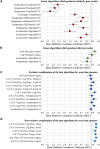Adherence Monitor for Measurement of Removable Cast Walker Wear-Time: Multiple Sensors and Predictive Analytics Improve Accuracy
- PMID: 39711522
- PMCID: PMC11664564
- DOI: 10.1177/19322968241304751
Adherence Monitor for Measurement of Removable Cast Walker Wear-Time: Multiple Sensors and Predictive Analytics Improve Accuracy
Abstract
Background: Treatment of diabetes and its complications is a primary health care expense. Up to 25% of people with diabetes will develop diabetic foot ulcers (DFUs). Removable cast walker (RCW) boots commonly prescribed for DFU treatment, promote healing, and provide offloading and wound protection. Patient RCW removal for hygiene and wound care can lead to decreased adherence and treatment effectiveness. This study evaluated a new system for wear-time adherence measurement using multiple sensor types.
Methods: An electronic wear-time monitor was developed, which included internal and external temperature sensors, an accelerometer, and capacitive proximity foot and ankle sensors. Time-stamped and date-stamped data were saved once per minute for up to 22 days. Ten healthy volunteer subjects were recruited to wear an RCW for two weeks while keeping a diary of don/doff times. Sensor data were then compared with volunteers' wear diaries using confusion matrix predictive analytics.
Results: Algorithms were developed for data processing. Correlation coefficients between algorithms and diaries were calculated for individual and multiple sensor combinations. Differential temperature and accelerometer algorithms were significantly better at predicting subject wear-time than individual temperature sensor algorithms (P = .009, P = .001, respectively). Foot proximity had significantly better correlation with subject diaries than temperature (P = .024), and acceleration algorithms (P = .005). Multi-sensor analysis showed high correlation (.96) with wear-time from subject diaries.
Conclusions: Removable cast walker wear-time can be accurately determined using an electronic data recorder and multiple sensors. Wear-time measurement accuracy can be improved using algorithms that operate on data from multiple sensors that use a variety of sensor technologies.
Keywords: adherence; adherence monitor; diabetic foot ulcer; orthosis wear-time; removable cast walker; wear-time.
Conflict of interest statement
Declaration of Conflicting InterestsThe author(s) declared no potential conflicts of interest with respect to the research, authorship, and/or publication of this article.
Figures




Similar articles
-
Differences in adherence to using removable cast walker treatment during daytime and nighttime weight-bearing activities in people with diabetes-related foot ulcers.Ther Adv Endocrinol Metab. 2023 Jan 10;14:20420188221142457. doi: 10.1177/20420188221142457. eCollection 2023. Ther Adv Endocrinol Metab. 2023. PMID: 36643893 Free PMC article.
-
Factors associated with adherence to using removable cast walker treatment among patients with diabetes-related foot ulcers.BMJ Open Diabetes Res Care. 2022 Feb;10(1):e002640. doi: 10.1136/bmjdrc-2021-002640. BMJ Open Diabetes Res Care. 2022. PMID: 35144940 Free PMC article.
-
Offloading effects of a removable cast walker with and without modification for diabetes-related foot ulceration: a plantar pressure study.J Foot Ankle Res. 2023 May 11;16(1):27. doi: 10.1186/s13047-023-00625-z. J Foot Ankle Res. 2023. PMID: 37170147 Free PMC article.
-
Effectiveness of offloading interventions for people with diabetes-related foot ulcers: A systematic review and meta-analysis.Diabetes Metab Res Rev. 2024 Mar;40(3):e3650. doi: 10.1002/dmrr.3650. Epub 2023 Jun 8. Diabetes Metab Res Rev. 2024. PMID: 37292021
-
Effectiveness of offloading interventions to heal foot ulcers in persons with diabetes: a systematic review.Diabetes Metab Res Rev. 2020 Mar;36 Suppl 1(Suppl 1):e3275. doi: 10.1002/dmrr.3275. Diabetes Metab Res Rev. 2020. PMID: 32176438 Free PMC article.
References
-
- International Diabetes Federation. IDF Diabetes Atlas. 10th ed. Brussels, Belgium: International Diabetes Federation; 2021.
-
- Aring A, Jones D, Falko J. Evaluation and prevention of diabetic neuropathy. Am Fam Physician. 2005;71(11):2123-2128. - PubMed
-
- Armstrong DG, Boulton AJ, Bus SA. Diabetic foot ulcers and their recurrence. N Engl J Med. 2017;376(25):2367-2375. - PubMed
-
- Stockl K, Vanderplas A, Tafesse E, Chang E. Costs of lower-extremity ulcers among patients with diabetes. Diabetes Care. 2004;27(9):2129-2134. - PubMed
-
- Bellomo F, Lee S, McCarthy M, et al.. Management of the diabetic foot. Semin Vasc Surg. 2022;35(3):219-227. - PubMed
Grants and funding
LinkOut - more resources
Full Text Sources
Miscellaneous

